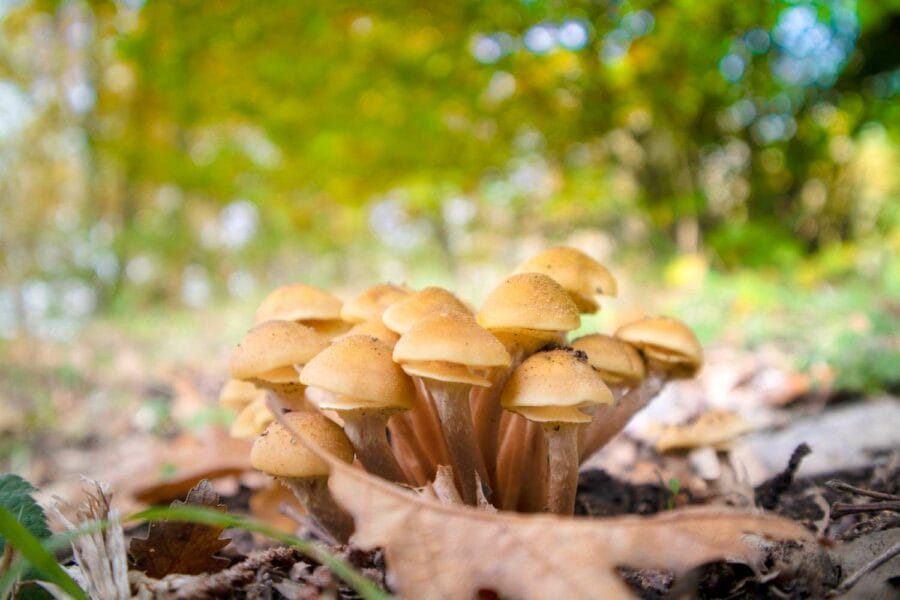Psilocybin, a psychoactive compound present in magic mushrooms, is often consumed recreationally for its euphoria-inducing and hallucinogenic effects.
Beyond its mind-altering capabilities, research has examined the compound’s potential merits in providing relief from chronic pain.
In this article, we delve into a case study that investigates the potential of microdosing mushrooms in mitigating chronic pain.
Key Takeaways:
- Potentially, both immediate and sustained pain relief can be achieved through microdosing mushrooms.
- When administered in small doses, psilocybin microdosing tends to exhibit fewer side effects compared to traditional pain medications.
- Psilocybin interacts with the serotonin 2A (5-HT2A) receptors, which may contribute to pain relief, among other potential benefits.

Study Details
The research, “Microdosing Psilocybin for Chronic Pain: A Case Series“, was led by Dr. Matthew Lyes and his team at the Division of Pain Medicine in the Department of Anesthesiology at the University of California, San Diego. The study focused on three patients who self-administered small quantities of psilocybin to manage their chronic pain symptoms.
Three Patients, One Result – Chronic Pain Reduction
Patient # 1
| AGE/ GENDER: | 37, Male |
| TYPE OF PAIN: | Neuropathic pain occurring below the site of a spinal cord injury. |
| PAIN LEVEL: | Initially rated 4 to 5/10, later increasing to 8/10 during the day |
| PSILOCYBIN DOSE: | 250 mg of ground mushroom for less than 6 months |
| RESULT: | Discontinuation of prescribed pain medication, decreased muscle spasms, and improved bowel movement efficiency. No signs of rebound pain or withdrawal symptoms. |
| The patient reported that while his usual medications merely moderated the pain, psilocybin effectively eliminated it, lowering his average pain level from 5 to 0. | |
Case Study: Subject #2
| AGE/ GENDER: | 69-year-old Female |
| TYPE OF PAIN: | Complex Regional Pain Syndrome (CRPS) |
| INTENSITY OF PAIN: | Typically fluctuates from 5 to 7 on a scale of 10, with an increase during physical activity and pain flare-ups |
| PSILOCYBIN DOSAGE: | Regular consumption of 500 mg for 7 to 10 days with intervals of 2 to 3 days throughout a year. Dosage is raised to 750 mg to 1 gram during episodes of pain flare-ups |
| IMPACT: | Pain is reduced by 80% for a duration of 3-4 hours, gradually returning to initial levels after 12 hours. Complete pain relief (90%-100%) is achieved for 6-8 hours, returning to initial levels after 18 hours. |
| The subject experiences a reduced appetite without any accompanying nausea. A noticeable disorientation or instability in walking is observed when the dosage is increased (750 to 1000mg). | |
Case Study: Subject # 3
| AGE/ GENDER: | 40-year-old Female |
| TYPE OF PAIN: | Lumbar radiculopathy and neuropathic pain |
| INTENSITY OF PAIN: | 8 on a scale of 10, rising to 10 during physical activity |
| PSILOCYBIN DOSAGE: | 1000 mg from a mushroom chocolate bar consumed every two months. |
| IMPACT: | Significant pain relief without experiencing any psychoactive effects. Improvement in flexibility and functionality is noted. Pain slowly reverts to initial levels over a period of 2-4 weeks. Repeat dosing enhances control over pain. |
| The subject reports no significant physical, cognitive, or behavioural side effects. Her mood remains mostly stable. She continues her regular dosage of her SSRI for depression management during the psilocybin treatment period. | |
Deciphering Pain Management with Psilocybin
Chronic somatic and visceral pain signals strengthen specific neural pathways due to peripheral and central sensitisation, resulting in a persistent experience of physical and emotional pain. Psychedelics like psilocybin stimulate 5-HT2A receptors, which could potentially reset the brain regions associated with neuropathic conditions.
One patient reported enduring pain relief for several weeks. This suggests that by directly stimulating the 5-HT2A receptors, pain perception and
This refers to the adaptability of synapses.
Potential Side Effects: Psilocybin vs. Traditional Pain Relievers
| PSILOCYBIN (Based on Studies) | TRADITIONAL PAIN RELIEVERS |
| Muscle spasms | Nausea |
| Decreased appetite | Stomach discomfort |
| Bewilderment | Migraines |
| Unsteady gait | Addiction |
| No change in mood | Drowsiness |
Future Research Possibilities for Psilocybin
The researchers, having analyzed the experiences of three subjects, have identified potential areas of interest that deserve further investigation due to their potential benefits.
- Small psilocybin doses may provide immediate and possibly long-lasting relief from neuropathic pain, without the risk of physical tolerance or addiction.
- Explore the effects of different treatment protocols used in conjunction with psilocybin. For example, patient #3 reported improved pain relief when psilocybin was combined with physical therapy.
- Even without psychotherapeutic intervention, small psilocybin doses could alleviate pain, as shown in this case study. The researchers propose that incorporating therapeutic guidance could potentially enhance or extend the therapeutic outcomes.
Study Limitations
Despite the encouraging outcomes seen in the subjects, it’s critical to acknowledge the limitations identified in the study.
- The study’s small sample size may not provide a comprehensive representation of all individuals with neuropathic pain.
- No subjects who were unresponsive to psilocybin were included in the study.
- No assessments were conducted before and after the treatment to evaluate the impact of psilocybin on psychiatric disorders like depression and anxiety.
- Most of the data was self-reported by the subjects.
- The presence of the interviewer and potential bias towards psilocybin could have influenced the participants’ responses.
- The study didn’t investigate the potential influence of the placebo effect.
- The study did not determine the psilocybin concentration in each mushroom.
Utilizing Mushrooms for Microdosing
In the experiment under discussion, Patients #1 and #2 consumed a microdose of powdered psilocybin derived from dried mushrooms, while patient #3 chose to mix it with chocolate. There are numerous specially designed products for microdosing psilocybin, and we’ve gathered a selection of them below.
Dried Mushrooms
Although the study did not disclose the specific strain used, the strain listed below can be a suitable choice for those new to the process.
- Golden Teacher: This strain is one of the most prevalent and commonly observed types of magic mushrooms.
- Amazonian Cubensis: Renowned for its user-friendliness. It can offer cognitive enhancements.
- Cambodian: Microdosing with Cambodian cubensis mushrooms can improve focus, social awareness, and mood.
Microdose Capsules
- Euphoria Psychedelics – Micro Calm Capsules: This combination includes Ashwagandha, Reishi, CBD, Valerian root, and Psilocybin Mushrooms, all known to scientifically reduce stress and anxiety.
- Ground Sounds – Microdose Capsules – Champion Lover: This intriguing blend offers three dosage options: 50mg, 100mg, or 250mg of pure psilocybin mixed with reishi, cacao, cordyceps, and maca.
- Kind Stranger – Brighten Capsules 250mg: These capsules incorporate the Golden Teacher strain, recognized for promoting clarity, enhancing creativity, and improving focus.
Pain Management with Psilocybin
While the research on mushrooms’ pain-relieving abilities is still in the preliminary stages, anecdotal reports and minor case studies are offering promising results.
Such instances underline the necessity for more extensive research into the potential benefits of psilocybin, class=”wp-block-list”>
Especially when it comes to chronic pain management, psilocybin is growing in acceptance.
The promising results of case studies have begun to inspire hope in those who experience chronic pain, even before psilocybin’s widespread acceptance for pain relief.
Frequently Asked Questions
What effects can psilocybin microdosing have?
Psilocybin mainly stimulates a serotonin receptor known as “5-HT2A” in the prefrontal cortex, leading to two primary outcomes:
- The creation of “Brain-Derived Neurotrophic Factor” (BDNF)
- An increase in “Glutamate” transmission
Furthermore, psychedelics can foster connections between brain regions that don’t usually interact. This distinctive connectivity is a result of these substances’ ability to decrease the activity of the “Default Mode Network” (DMN), which is involved in a variety of cognitive processes, such as daydreaming, self-reflection, and contemplation of the past and future.
What is the most recognized benefit of mushroom microdosing?
Microdosing may enhance mood, productivity, creativity, and focus. Its most extensively researched benefit is its influence on mental health.
In November 2022, COMPASS Pathways, a company focusing on mental health, shared the findings of their extensive phase 2b trial, a randomized and double-blind study. According to their research, a single dose of psilocybin significantly reduced depressive symptoms compared to a placebo. Participants who received a higher dose of 25 milligrams maintained an antidepressant response at the twelve-week follow-up.
A study published in the Psychiatry Research Journal suggested that psilocybin is more effective than traditional antidepressant treatments.
How can you determine your dosage?
Start with a 0.1-gram dose of psilocybin mushrooms on the first day. If the desired effects are not achieved, you may incrementally increase your dose by 0.05 grams on subsequent microdosing days until you find your ideal amount.
Individuals with a history of psychotropic drug use might need to increase the dose to 0.5 grams to get the desired effects.
What steps should be taken before consuming mushrooms?
class=”wp-block-list”>What is the suggested frequency for taking microdoses of mushrooms?
There exist several well-recognized protocols that provide structured microdosing schedules for psychedelics. These protocols primarily differ in the number of “off” days they incorporate, which are the days when you abstain from microdosing.
The most frequently suggested protocols advise including 1-3 rest days between microdoses. This aligns with the body’s natural tolerance mechanisms. The three protocols discussed in this context are the Fadiman Protocol, the Stamets Stack, and intuitive microdosing.




